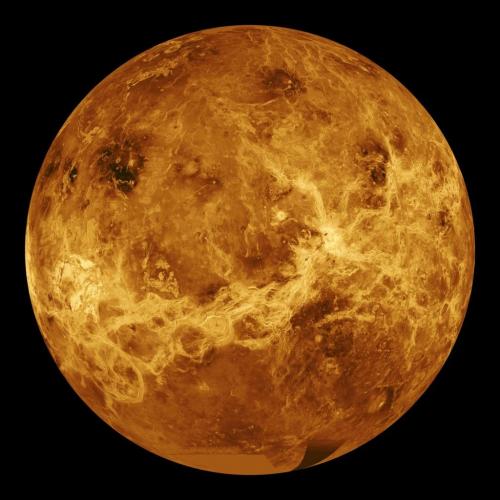Venus has long been considered Earth’s twin sister. The two planets are very similar in some respects and share many physical and orbital characteristics:
- inner planets
- varying terrains on the surface: mountains, plains, high plateux, gorges, volcanoes, crests and impact craters
- few craters, implying a relatively young surface
- atmospheres with dense clouds
- very close chemical compositions
- closest neighbouring planets
They are born at about the same time in the same cloud of gas and dust, 4.6 billion years ago.
Because of these similarities, we had long thought that below the dense clouds, Venus could be like the Earth and could maybe even harbour life.
But Venus is very different from the Earth in many respects
| Venus | Earth | Ratio (Venus/Earth) | |
|---|---|---|---|
| Mass (1024 kg) | 4.8685 | 5.9736 | 0.815 |
| Volume (1010 km3) | 92.843 | 108.321 | 0.857 |
| Equatorial radius (km) | 6051.8 | 6378.1 | 0.949 |
| Polar radius (km) | 6051.8 | 6356.8 | 0.952 |
| Volumetric mean radius (km) | 6051.8 | 6371.0 | 0.950 |
| Ellipticity (Flattening) | 0.000 | 0.00335 | 0.0 |
| Venus | Earth | |
|---|---|---|
| Number of natural satellites | 0 | 1 |
| Planetary ring system | No | No |
| Surface pressure (bar) | 92 | 1.013 |
| Average surface temperature | 464 °C | 14 °C |
| Atmospheric composition | 96.5% CO2 + 3.5% N2 | 77%N2 + 21% O2 |
| Topographic range (km) | 15 | 20 |
| Venus | Earth | Ratio (Venus/Earth) | |
|---|---|---|---|
| Mean density (kg/m3) | 5243 | 5515 | 0.951 |
| Surface gravity (eq.) (m/s2) | 8.87 | 9.80 | 0.905 |
| Surface acceleration (eq.) (m/s2) | 8.87 | 9.78 | 0.907 |
| Escape velocity (km/s) | 10.36 | 11.19 | 0.926 |
| GM (x 106 km3/s2) | 0.3249 | 0.3986 | 0.815 |
| Bond albedo | 0.750 | 0.306 | 2.45 |
| Visual geometric albedo | 0.65 | 0.367 | 1.77 |
| Visual magnitude V(1,0) | -4.40 | -3.86 | - |
| Solar irradiance (W/m2) | 2613.9 | 1367.6 | 1.911 |
| Black-body temperature (K) | 231.7 | 254.3 | 0.911 |
| Moment of inertia (I/MR2) | 0.33 | 0.3308 | 0.998 |
| J2 (x 10-6) | 4.458 | 1082.63 | 0.004 |


